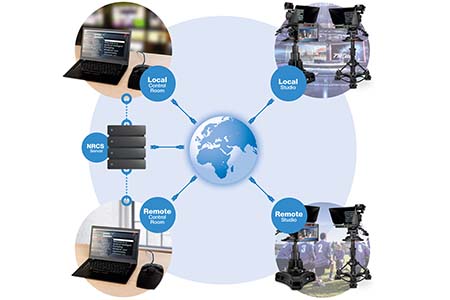Intelligent Prompting monitors can be identified on the IP network and controlled both locally and remotely by a single operator from a centralized location. The operator can access multiple prompters and determine instantly whether each is functioning correctly.

As media operations continue their migration from baseband SDI to packet-based Internet Protocol (IP) workflows, operators and system engineers are rethinking their approach to all aspects of production. A lot of the focus is on moving video routers, cameras, switchers, and other components to IP, but studio engineers and system integrators would be wise not to overlook that ancillary but critical element of production teleprompting.
For IP-based production facilities to succeed, prompting systems will have to be brought into the new world of packet-based signal distribution workflows. The prompting system must fit seamlessly into the fully networked and geographically dispersed IP production facilities that are now under development in many parts of the world.
At Autoscript, weve built a solid base of teleprompting customers in the Middle Eastern broadcasting community. One showcase installation is a state-of-the-art, greenfield broadcast facility for the newly launched Al-Mamlaka 24-hour news channel, Jordans first state-funded public broadcaster.
With a track record of success in facilities like Al-Mamlaka, we set out to develop a next-generation prompting system. To meet the above requirements, this solution would need not only to be compatible with our large installed base of video teleprompters, but also optimized for the IP age and powered by built-in intelligence from software to hardware. In this article, well describe how we met the requirements for an intelligent prompting solution and the key benefits.
Intelligent Monitors
Intelligent Prompting monitors can be identified on the IP network and controlled both locally and remotely by a single operator from a centralized location. The operator can access multiple prompters and determine instantly whether each is functioning correctly.
With built-in intelligent scroll technology, each monitor can render the script image locally from small unicast data packets sent from the prompting software. In this manner, the prompting system can avoid sending video over IP and sidestep the drawbacks that go with it, including lack of bandwidth, latency issues, and synchronization errors. With much less data sent over the IP network, all of the monitors can remain in constant communication with the master application to ensure reliable synchronization and easier operation.
Centralized, Global Control
By connecting through an IP network, Intelligent Prompting allows an operator to control the system locally or from anywhere in the world. For instance, an operator in Dubai is able to control a local prompter and then, from the same workstation, begin operating a prompter in Riyadh. The prompting system can send control signals over an IP network to the prompting monitor to manage script, speed, and other attributes, whether the monitor is located down the hall or across the globe.
Because it is using data rather than video over IP, the Intelligent Prompting workflow makes these capabilities possible with speed and accuracy, and offers the potential to reduce crew costs across locations. Coverage of large, multinational sporting events is an excellent candidate for this, as illustrated by one of our customers at this summers global football event. The broadcaster deployed an Intelligent Prompting workflow across two continents with two prompting operations, one at local HQ and one locally at the event. Whichever location was directing the content also controlled the prompting, enabling the two sites to share resources efficiently.
Built-in Redundancy

Intelligent Prompting creates connectivity without requiring point-to-point connections, and therefore delivers core redundancy. At the prompting application level, this enables a full-redundancy fail-safe by which a mirrored PC, paired with the main application, can seamlessly take over with a single click if the first PC/application fails with automatic synchronisation of script position, individual users settings, controllers, newsroom connections, teleprompters, etc. When the first application recovers, it drops into standby mode, at the ready should the active PC fail.
Since all elements of the prompting system are networked devices and therefore not physically connected to each other, the existing controller(s) can continue working with prompts from the backup machine, wherever it is in the world. Because the switch from the host PC to the backup is immediate, the on-air talent might notice nothing more than a fractional, millisecond pause in the scroll speed if he or she notices anything at all.
Streamlined Cabling
An IP-based prompting system can allow all elements to be connected with standard, off-the-shelf Ethernet (Cat-5/6) cable, which means the prompting system can be easily and efficiently integrated with other equipment. In addition, Power over Ethernet (PoE) can remove the need for additional power supplies to drive devices such as desktop hand controllers and foot controllers.
The Intelligent Prompting solution also integrates key IP technologies tightly into the prompting infrastructure. One such technology is Network Time Protocol, which allows all devices on the network to be accurately synced both locally and globally and keeps cabling requirements to a minimum.
A Flexible, Reliable, and Easy-to-Use Prompter
By adding Ethernet connectivity into every component of a prompting system, we have created a complete IP workflow and our approach using small data packets ensures fully compatible integration with other elements of an IP installation. The availability of built-in video inputs helps to ensure a smooth transition to IP as broadcast facilities evolve. These factors add up to give users the necessary flexibility to improve productivity and realize more efficient resource management in any part of their prompting system.
At the end of the day, broadcasters and production studios want a seamless prompting workflow that combines the connectivity, flexibility, ease of use, and reliability required in the highly competitive environment in which they operate. Thanks to breakthroughs in prompting over IP, such workflows are now possible. Indeed, the new age of IP-based prompting systems promises to have a profound impact on general broadcast operations, as well as on the nature of prompting itself.
Robin Brown is product manager for the Vitec Groups Autoscript and Autocue brands.










































































